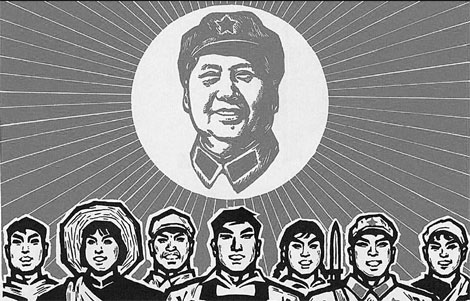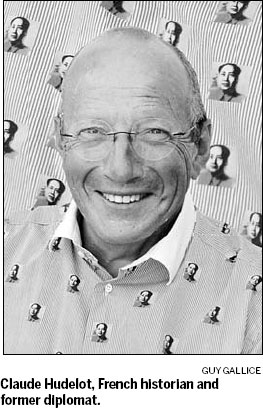Man of red letters
 |
|
A poster published in the book. |
French historian and former diplomat Claude Hudelot feels a red-hot passion for understanding China's past leadership.
The centerpiece of his fascination has remained former Chairman Mao Zedong (1893-1976).
He has written several books on the late leader, such as The Long March (1971) and Mao: The Life and the Legend (2001). In addition, he has produced several film documentaries like Hou Bo and Xu Xiaobing, Photographers of Mao (2003).
The 68-year-old's newest book, The Mao Cult, focuses on visual elements related to China's foremost founding father. It features calligraphy, photographs, paintings, badges, and statues and busts of Mao. It also reveals the stories behind these images.
Hudelot created the book with French photographer Guy Gallice.
Claude Hudelot's newest book, The Mao Cult, features visual elements of former Chairman Mao Zedong. Provided to China Daily The more than 800 images were selected from more than 2,000 belonging to his and Gallice's personal collections, and from private museums in Shandong province's Qufu, Fujian province's Shantou, Jiangxi province's Jingdezhen and Hong Kong.
Hudelot's visual approach to depicting Mao differs from that of most historians, who focus on texts and documents. In addition to poring over books, he has also viewed many photos and films depicting Mao.
"I believe that not only for Mao but also for other leaders who have changed history, you have to look carefully at the images, read the poems and see the calligraphy," Hudelot says.
He explains that he strongly dislikes the bestseller Mao: The Unknown Story by Jon Halliday and Jun Chang.
"It is a book of revenge. It's too critical," he says.

"I believe when you read reports like the one on the Lushan Conference and the way he talked to Peng Dehuai, then China's Defense Minister, during the summer 1959, and then see the photo Hou Bo took of him in a bathing suit laughing with young friends by a lake at Lushan Mountain, you understand how complex this person is."
In addition to his work on Mao, Hudelot has been involved in numerous Sino-French cultural activities. He has produced many written works, radio shows and television documentaries about China.
"China is the biggest part of my life," he says. "There is no distance between China and me except the distance of the flight."
Hudelot's fascination with China began in 1964. When his father was transferred from India to work as director of the Alliance Francaise in Hong Kong, Hudelot took a train from Paris through Moscow to Beijing.
He knew nothing about the country but was impressed during the first visit.
"The Chinese were very poor and revolutionary," he says.
Hudelot recalls seeing people clad in the same patched-up blue clothing, basic food, and throngs of bicycles on the streets.
"Where are all those bicycles now? They've disappeared from China and seem be showing up in Europe," he says, laughing.
He began studying Chinese after returning to France and earned a master's degree in contemporary Chinese history from the French National Oriental University in 1969.
 0
0 







Go to Forum >>0 Comments